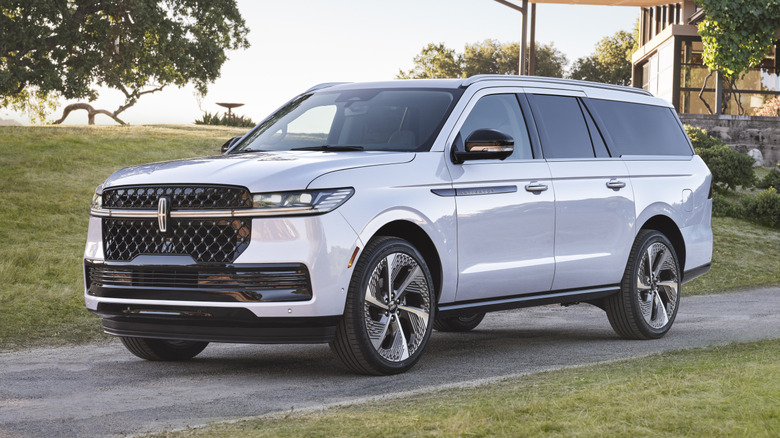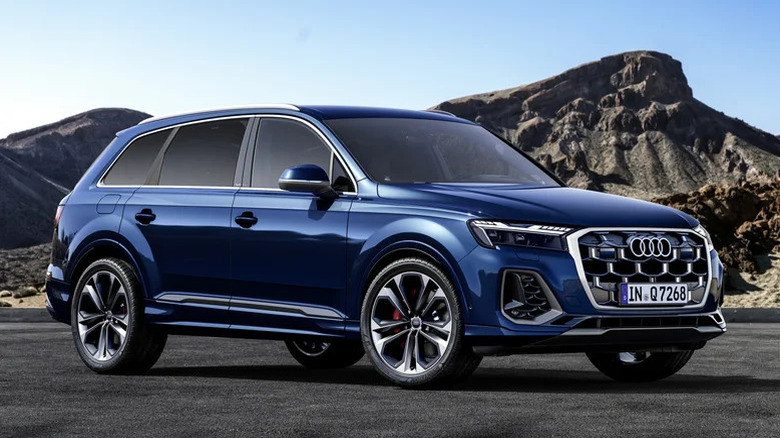9 Of The Worst-Depreciating SUVs In 2025
Unless you happen to be driving an ultra-limited edition hypercar or a sought-after classic, your car will almost certainly be subject to some level of depreciation over the course of your ownership. As it gets older and racks up mileage, used buyers will be willing to pay less and less for your car, although if you're careful with your choice of vehicle, you can minimize these losses.
When it comes to SUVs, choosing a model with wide appeal is key to getting the best resale value when you upgrade. It's no coincidence that many of the highest resale value SUVs are bestselling models from the likes of Toyota, Honda, and Hyundai — they all have a strong reputation for reliability among owners, and they're safe, spacious, and cheap to run.
However, on the other end of the resale value spectrum, some SUV models stick out as being particularly fast-depreciating. These nine models are among the very worst on the market according to iSeeCars data, with each one losing at least 60% of their original sticker price after five years on the road.
Lincoln Navigator L — 60.3%
If you ignore its high depreciation levels, there's a lot to like about the 2025 Lincoln Navigator. It's huge, plush, and filled with plenty of gadgetry, plus it boasts 440 horsepower from its 3.5-liter V6 engine. We thought it was easy to drive, too, despite its oversized proportions. It's hard to describe any full-size SUV as handsome, but the Navigator is at least one of the smarter-looking models in its segment. It doesn't have the same over-the-top presence or throaty soundtrack as a Cadillac Escalade V, although it's still more than fast enough for everyday driving situations.
It's also not as expensive as a top-spec Escalade, although it's a tad pricier than a base-spec Caddy. The regular Navigator technically starts at just under $100,000, but it's very unlikely that any buyers will actually pay less than six figures thanks to the car's generous options list. The extended wheelbase L variant adds roughly $3,000 to the total.
It's safe to assume that most Navigator buyers won't be paying too much attention to the car's final price, nor its resale value — this isn't a car one buys as a prudent investment. Buyers can expect to lose a little over 60% of their original investment after the Lincoln's first five years on the road.
Tesla Model Y — 60.4%
It's often the case that cars that depreciate the fastest were relatively expensive to buy new, but the Tesla Model Y is the exception to the rule. It starts around $40,000 at the time of writing — although Tesla's pricing structure frequently changes — yet it still loses more than 60% of its value over half a decade. Part of that low resale value might be down to Tesla's aforementioned price changes, since the 2020 model started at around $50,000. Even without accounting for inflation, that means the Model Y has been subject to a roughly $10,000 MSRP reduction in the five years, which will have had a significant impact on resale values.
The recent refresh of the Model Y was evolutionary rather than revolutionary, and still doesn't include the long-promised self-driving capabilities that many Tesla fans, including SlashGear writer Jack Picone, had hoped for. We might have been slightly disappointed by the refresh, but scores of buyers evidently weren't. Tesla already sold around 170,000 examples of the car in the U.S. between January and September 2025, making the Model Y the most popular car on this list as well as the cheapest to buy new.
Land Rover Discovery — 60.9%
The first generation of the Land Rover Discovery is arguably one of the most iconic Land Rovers ever produced. It combined the off-road capabilities of the brand's other models with the sensibility of a family hauler, and helped shape the family SUV segment in the process. The latest generation of the Land Rover Discovery isn't as innovative, and it's also getting long in the tooth, since it's been around since 2018. A refresh for the 2021 model year saw the Discovery gain new tech and a mild facelift, but in the fast-moving world of luxury SUVs, it's still one of the older models in the segment.
It has also been overshadowed in more recent years by the relaunched Defender, which arguably has the edge in terms of styling and also boasts superior all-terrain capability. With a broad variety of rivals available both from other manufacturers and from within the JLR stable, it's tricky to find many reasons to opt for a Discovery in 2025. Making matters worse is its poor resale value, which sees buyers expected to lose 60.9% of their original investment on average over the course of five years.
Infiniti QX60 — 61.5%
Plenty of rumors have surfaced recently about whether or not Infiniti is going out of business. It remains unclear what the brand's future holds, but either way, the rumors certainly aren't reassuring for potential Infiniti customers. Used buyers might be particularly concerned, since servicing and parts availability for recently out-of-warranty cars could be compromised if Nissan decides to retire its luxury arm.
Perhaps that uncertainty is part of the reason why SUVs like the Infiniti QX60 lose the majority of their resale value — around 61.5% — after five years on the road. Alternatively, it might simply be that there are better used options on the market. After all, we thought the latest QX60 wasn't particularly competitive when it was new, with an underwhelming engine and a high retail price given what it offered. While its interior was certainly a step above the Nissan Pathfinder, with which the QX60 is mechanically related, we thought the Infiniti was too mediocre in other areas to be a worthwhile upgrade.
Audi Q7 — 61.6%
Although Audi has given the Q7 a facelift for 2025, it isn't a major one. Mostly, it consists of some revamped infotainment technology and some minor styling tweaks. Whether or not it needed a more major overhaul is a subjective question: the outgoing Q7 was far from dated, but likewise, the luxury SUV segment moves so fast that buyers have come to expect significant changes every few years. Perhaps overhauling the Q7 simply wasn't a priority for Audi, as the brand continues to develop and roll out its all-electric e-tron range.
Whatever the reason for the facelift being so minor, the result is that buyers have relatively little incentive to buy a new example, unless it's simply for the sake of buying a new car. A Q7 that's a few years old will have already lost a significant chunk of its original value, and it won't be all that different to the latest version, at least not mechanically. Buying a five year old example will save even more money, with iSeeCars estimating that 2020 models have lost 61.6% of the original value on average.
Land Rover Range Rover — 62.9%
Ever since it first hit dealerships in 1970, the Range Rover has carved out a reputation for itself as the ultimate luxury off-roader. Throughout the decades, Land Rover has kept the car's core DNA unaltered, and today it remains a versatile all-rounder that blends in just as well in wealthy urban neighborhoods as it does on country estates.
For those who can afford it, the car remains an undeniably appealing choice, but its sky-high price and questionable reliability mean that it loses value very quickly. Almost two-thirds of its sticker value will be lost after its first half-decade on the road.
To put that figure into context, the average American drives 13,476 miles per year, according to the Federal Highway Administration. A base-spec Range Rover starts at around $115,000 — and keep in mind, options can push that final price far higher. At average depreciation rates, even a base Range Rover would lose around $72,335 over half a decade, which equates to roughly $1.07 per mile in depreciation alone over that period.
Cadillac Escalade ESV — 62.9%
The "ESV" version of the Cadillac Escalade has a longer wheelbase than the standard SUV, with the name standing for Escalade Stretch Vehicle. The standard Escalade is already a seriously bulky car, but the ESV adds a few extra inches for an even more cavernous interior. The latter also depreciates slightly faster than its standard wheelbase sibling, and is expected to lose 62.9% of its value after half a decade on average.
Like almost all luxury cars, well-heeled buyers place value in having the latest and greatest iteration of the SUV. As it ages, and its first owners trade it in for an upgrade, the Escalade's running costs make it much less attractive to used buyers. According to KBB, owners can expect to spend around $18,000 on insuring the Escalade over the course of five years, as well as almost $17,000 on fuel. That's without taking into account servicing and repair costs, or financing and taxes.
Tesla Model X — 63.4%
Tesla currently offers two SUVs, the Model Y and Model X. The Model Y competes in the tightly packed value-oriented family SUV market, while the Model X is significantly pricier and more of an upmarket option. It's also roomier and features falcon-wing doors, which remain unique compared to the Model X's rivals, even if the doors don't really offer much aside from novelty value.
Unless you really, absolutely need an SUV with a pair of Falcon doors, it's hard to think of many reasons to pick a used Model X over a used Model Y. It's also increasingly difficult to find reasons to purchase a new Model X, particularly since it now carries a starting price of around $100,000. Value retention certainly isn't one of the remaining reasons, since the Model X is expected to lose an average of 63.4% of its value after five years on the road.
Infiniti QX80 — 65.0%
We previously crowned the Infiniti QX80 one of the brand's best cars, but it's still not considered the best in its segment. It faces tough competition from both American and European rivals, particularly from German carmakers. The QX80 is suitably luxurious given its price tag, which starts around $85,000 and can stretch well into six figures, depending upon its trim and options. However, other rivals offer more unique selling points.
The Cadillac Escalade is a brawny, all-American interpretation of modern luxury, the Range Rover is the classy British stalwart of the segment, and the Mercedes-Benz GLS is the practical, plush, family-hauling all-rounder. With so much competition, Infiniti was always going to face an uphill battle getting buyers to care about the QX80. It might be a good car in isolation, but simply being good isn't enough to get noticed in its segment. Nor is it enough to keep used buyers interested, since the QX80 will lose 65% of its sticker value on average after five years.
Our selection methodology
To compile this list of fast-depreciating cars, we used data from the research platform iSeeCars, which compiled pricing data from more than 800,000 used car listings to establish depreciation rates for each SUV model. This is not intended to be an exhaustive list of every fast-depreciating SUV, and models that were launched after the 2020 model year were not included in the data. All depreciation figures represent overall averages based on historical data, and individual rates of depreciation may vary significantly based on a particular vehicle's condition or ownership history.










